Yamaha PSR-248 User Manual
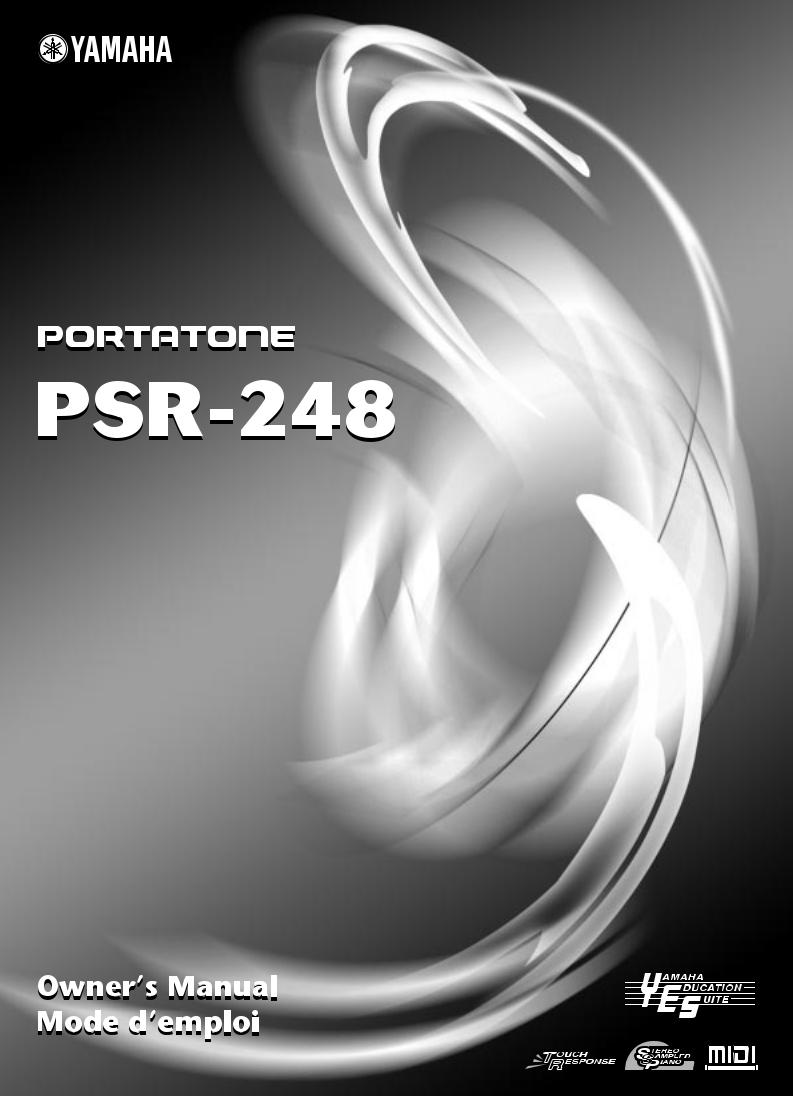

SPECIAL MESSAGE SECTION
This product utilizes batteries or an external power supply (adapter). DO NOT connect this product to any power supply or adapter other than one described in the manual, on the name plate, or specifically recommended by Yamaha.
This product should be used only with the components supplied or; a cart, rack, or stand that is recommended by Yamaha. If a cart, etc., is used, please observe all safety markings and instructions that accompany the accessory product.
SPECIFICATIONS SUBJECT TO CHANGE:
The information contained in this manual is believed to be correct at the time of printing. However, Yamaha reserves the right to change or modify any of the specifications without notice or obligation to update existing units.
This product, either alone or in combination with an amplifier and headphones or speaker/s, may be capable of producing sound levels that could cause permanent hearing loss. DO NOT operate for long periods of time at a high volume level or at a level that is uncomfortable. If you experience any hearing loss or ringing in the ears, you should consult an audiologist.
IMPORTANT: The louder the sound, the shorter the time period before damage occurs.
NOTICE:
Service charges incurred due to a lack of knowledge relating to how a function or effect works (when the unit is operating as designed) are not covered by the manufacturer’s warranty, and are therefore the owners responsibility. Please study this manual carefully and consult your dealer before requesting service.
ENVIRONMENTAL ISSUES:
Yamaha strives to produce products that are both user safe and environmentally friendly. We sincerely believe that our products and the production methods used to produce them, meet these goals. In keeping with both the letter and the spirit of the law, we want you to be aware of the following:
battery is approximately five years. When replacement becomes necessary, contact a qualified service representative to perform the replacement.
This product may also use “household” type batteries. Some of these may be rechargeable. Make sure that the battery being charged is a rechargeable type and that the charger is intended for the battery being charged.
When installing batteries, do not mix batteries with new, or with batteries of a different type. Batteries MUST be installed correctly. Mismatches or incorrect installation may result in overheating and battery case rupture.
Warning:
Do not attempt to disassemble, or incinerate any battery. Keep all batteries away from children. Dispose of used batteries promptly and as regulated by the laws in your area. Note: Check with any retailer of household type batteries in your area for battery disposal information.
Disposal Notice:
Should this product become damaged beyond repair, or for some reason its useful life is considered to be at an end, please observe all local, state, and federal regulations that relate to the disposal of products that contain lead, batteries, plastics, etc. If your dealer is unable to assist you, please contact Yamaha directly.
NAME PLATE LOCATION:
The name plate is located on the bottom of the product. The model number, serial number, power requirements, etc., are located on this plate. You should record the model number, serial number, and the date of purchase in the spaces provided below and retain this manual as a permanent record of your purchase.
Model
Battery Notice: |
Serial No. |
|
|
This product MAY contain a small non-rechargeable battery which (if |
|
applicable) is soldered in place. The average life span of this type of |
Purchase Date |
92-BP (bottom) |
PLEASE KEEP THIS MANUAL |
||
|
|
||
|
|
||
|
|
||
|
FCC INFORMATION (U.S.A.) |
||
1. IMPORTANT NOTICE: DO NOT MODIFY THIS UNIT! |
devices. Compliance with FCC regulations does not guarantee |
||
This product, when installed as indicated in the instructions |
that interference will not occur in all installations. If this product |
||
is found to be the source of interference, which can be |
|||
contained in this manual, meets FCC requirements. Modifica- |
|||
determined by turning the unit “OFF” and “ON”, please try to |
|||
tions not expressly approved by Yamaha may void your |
|||
eliminate the problem by using one of the following measures: |
|||
authority, granted by the FCC, to use the product. |
|||
Relocate either this product or the device that is being affected |
|||
2. IMPORTANT: When connecting this product to accessories |
|||
and/or another product use only high quality shielded cables. |
by the interference. |
||
Cable/s supplied with this product MUST be used. Follow all |
Utilize power outlets that are on different branch (circuit breaker |
||
installation instructions. Failure to follow instructions could void |
or fuse) circuits or install AC line filter/s. |
||
your FCC authorization to use this product in the USA. |
In the case of radio or TV interference, relocate/reorient the |
||
3. NOTE: This product has been tested and found to comply with |
antenna. If the antenna lead-in is 300 ohm ribbon lead, change |
||
the requirements listed in FCC Regulations, Part 15 for Class |
the lead-in to co-axial type cable. |
||
“B” digital devices. Compliance with these requirements |
If these corrective measures do not produce satisfactory results, |
||
provides a reasonable level of assurance that your use of this |
please contact the local retailer authorized to distribute this type |
||
product in a residential environment will not result in harmful |
of product. If you can not locate the appropriate retailer, please |
||
interference with other electronic devices. This equipment |
contact Yamaha Corporation of America, Electronic Service |
||
generates/uses radio frequencies and, if not installed and used |
Division, 6600 Orangethorpe Ave, Buena Park, CA90620 |
||
according to the instructions found in the users manual, may |
The above statements apply ONLY to those products distributed |
||
cause interference harmful to the operation of other electronic |
|||
by Yamaha Corporation of America or its subsidiaries. |
|||
|
|
||
|
|
||
* This applies only to products distributed by YAMAHA CORPORATION OF AMERICA. |
(class B) |
||
Entsorgung leerer Batterien (nur innerhalb Deutschlands)
Leisten Sie einen Beitrag zum Umweltschutz. Verbrauchte Batterien oder Akkumulatoren dürfen nicht in den Hausmüll. Sie können bei einer
Sammelstelle für Altbatterien bzw. Sondermüll abgegeben werden. Informieren Sie sich bei Ihrer Kommune.
(battery)
2
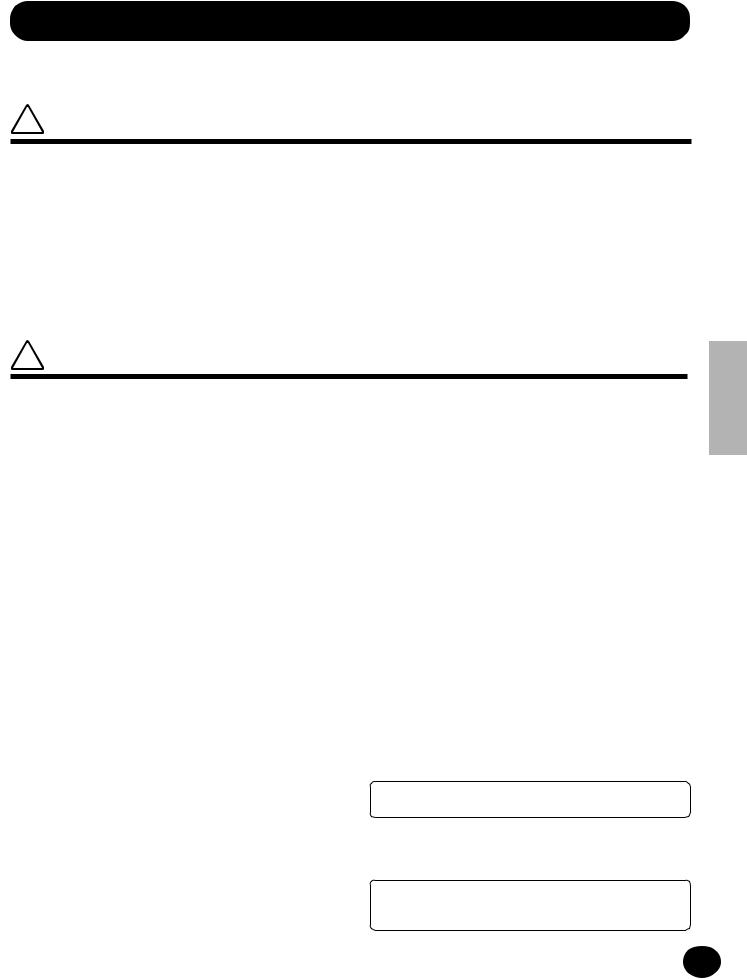
PRECAUTIONS
PLEASE READ CAREFULLY BEFORE PROCEEDING
* Please keep these precautions in a safe place for future reference.
 WARNING
WARNING
Always follow the basic precautions listed below to avoid the possibility of serious injury or even death from electrical shock, short-circuiting, damages, fire or other hazards. These precautions include, but are not limited to, the following:
•Do not open the instrument or attempt to disassemble the internal parts or modify them in any way. The instrument contains no user-serviceable parts. If it should appear to be malfunctioning, discontinue use immediately and have it inspected by qualified Yamaha service personnel.
•Do not expose the instrument to rain, use it near water or in damp or wet conditions, or place containers on it containing liquids which might spill into any openings.
•If the AC adaptor cord or plug becomes frayed or damaged, or if there is a sudden loss of sound during use of the instrument, or if any unusual smells or smoke should appear to be caused by it, immediately turn off the power
switch, disconnect the adaptor plug from the outlet, and have the instrument inspected by qualified Yamaha service personnel.
•Use the specified adaptor (PA-3B or an equivalent recommended by Yamaha) only. Using the wrong adaptor can result in damage to the instrument or overheating.
•Before cleaning the instrument, always remove the electric plug from the outlet. Never insert or remove an electric plug with wet hands.
•Check the electric plug periodically and remove any dirt or dust which may have accumulated on it.
 CAUTION
CAUTION
Always follow the basic precautions listed below to avoid the possibility of physical injury to you or others, or damage to the instrument or other property. These precautions include, but are not limited to, the following:
•Do not place the AC adaptor cord near heat sources such as heaters or radiators, and do not excessively bend or otherwise damage the cord, place heavy objects on it, or place it in a position where anyone could walk on, trip over, or roll anything over it.
•When removing the electric plug from the instrument or an outlet, always hold the plug itself and not the cord.
•Do not connect the instrument to an electrical outlet using a multiple-con- nector. Doing so can result in lower sound quality, or possibly cause overheating in the outlet.
•Unplug the AC power adaptor when not using the instrument, or during electrical storms.
•Always make sure all batteries are inserted in conformity with the +/- polarity markings. Failure to do so might result in overheating, fire, or battery fluid leakage.
•Always replace all batteries at the same time. Do not use new batteries together with old ones. Also, do not mix battery types, such as alkaline batteries with manganese batteries, or batteries from different makers, or different types of batteries from the same maker, since this can cause overheating, fire, or battery fluid leakage.
•Do not dispose of batteries in fire.
•Do not attempt to recharge batteries that are not intended to be charged.
•If the instrument is not to be in use for a long time, remove the batteries from it, in order to prevent possible fluid leakage from the battery.
•Keep batteries away from children.
•Before connecting the instrument to other electronic components, turn off the power for all components. Before turning the power on or off for all components, set all volume levels to minimum. Also, be sure to set the volumes of all components at their minimum levels and gradually raise the volume controls while playing the instrument to set the desired listening level.
•Do not expose the instrument to excessive dust or vibrations, or extreme cold or heat (such as in direct sunlight, near a heater, or in a car during the day) to prevent the possibility of panel disfiguration or damage to the internal components.
(4)-4
•Do not use the instrument near other electrical products such as televisions, radios, or speakers, since this might cause interference which can affect proper operation of the other products.
•Do not place the instrument in an unstable position where it might accidentally fall over.
•Before moving the instrument, remove all connected adaptor and other cables.
•When cleaning the instrument, use a soft, dry cloth. Do not use paint thinners, solvents, cleaning fluids, or chemical-impregnated wiping cloths. Also, do not place vinyl, plastic or rubber objects on the instrument, since this might discolor the panel or keyboard.
•Do not rest your weight on, or place heavy objects on the instrument, and do not use excessive force on the buttons, switches or connectors.
•Use only the stand/rack specified for the instrument. When attaching the stand or rack, use the provided screws only. Failure to do so could cause damage to the internal components or result in the instrument falling over.
•Do not operate the instrument for a long period of time at a high or uncomfortable volume level, since this can cause permanent hearing loss. If you experience any hearing loss or ringing in the ears, consult a physician.
■SAVING USER DATA
•Save all data to an external device such as the Yamaha MIDI Data Filer MDF3, in order to help prevent the loss of important data due to a malfunction or user operating error.
Yamaha cannot be held responsible for damage caused by improper use or modifications to the instrument, or data that is lost or destroyed.
Always turn the power off when the instrument is not in use.
Make sure to discard used batteries according to local regulations.
*The illustrations and LCD screens as shown in this owner’s manual are for instructional purposes only, and may be different from the ones on your instrument.
3
1

Congratulations on your purchase of the Yamaha PSR-248 PortaTone!
You now own a portable keyboard that combines advanced functions, great sound and exceptional ease-of-use in a highly compact package. Its outstanding features also make it a remarkably expressive and versatile instrument.
Read this Owner’s Manual carefully while playing your new PortaTone in order to take full advantage of its various features.
Contents
PANEL CONTROLS AND TERMINALS |
6 |
● Front Panel ...................................... |
6 |
● Rear Panel........................................ |
8 |
SETTING UP |
9 |
POWER REQUIREMENTS ............................ |
9 |
● Using an AC Power Adaptor ............ |
9 |
● Using Batteries ................................. |
9 |
TURNING ON THE POWER ........................ |
9 |
ACCESSORY JACKS .................................. |
10 |
MUSIC STAND......................................... |
10 |
GETTING STARTED — |
|
PLAYING THE DEMO SONGS |
11 |
PANEL DISPLAY INDICATIONS |
12 |
PORTABLE GRAND |
13 |
USING THE METRONOME ....................... |
13 |
● Setting the Metronome Time |
|
Signature ....................................... |
14 |
● Adjusting the Metronome Volume . 14 |
|
SELECTING AND PLAYING VOICES — |
|
THE VOICE MODE |
15 |
SELECTING AND PLAYING A VOICE ......... |
15 |
● Percussion Voice Chart |
|
(voices 90 and 100). ...................... |
17 |
TRANSPOSE AND TUNING ...................... |
18 |
● Transpose ...................................... |
18 |
● Tuning ........................................... |
19 |
TOUCH RESPONSE .................................. |
19 |
SELECTING AND PLAYING SONGS — |
|
THE SONG MODE |
20 |
SELECTING AND PLAYING A SONG ......... |
20 |
CHANGING THE TEMPO ......................... |
21 |
● About the Beat Display .................. |
22 |
ADJUSTING THE SONG VOLUME ............ |
23 |
SONG CONTROLS .................................. |
24 |
A/B REPEAT .............................................. |
24 |
MELODY GUIDE ....................................... |
26 |
VOICE CHANGE ........................................ |
27 |
SELECTING AND PLAYING STYLES — |
|
THE STYLE MODE |
28 |
SELECTING AND PLAYING A STYLE.......... |
28 |
STYLE CONTROLS ................................... |
30 |
USING THE AUTO ACCOMPANIMENT |
|
FEATURES ............................................. |
31 |
CHANGING THE TEMPO ......................... |
31 |
STYLE SECTIONS (MAIN A, MAIN B) AND |
|
FILL-INS ................................................ |
32 |
ADJUSTING THE ACCOMPANIMENT |
|
VOLUME .............................................. |
32 |
USING AUTO ACCOMPANIMENT — |
|
MULTI FINGERING................................ |
33 |
● Single Finger Chords ..................... |
33 |
● Fingered Chords ............................ |
33 |
WHAT IS A CHORD? ................................ |
34 |
WRITING CHORD NAMES ....................... |
35 |
● The Intervals of the Scale ............... |
35 |
● Other Chords ................................ |
35 |
ONE TOUCH SETTING (OTS) ................... |
36 |
CHORD GUIDE .......................................... |
37 |
● Smart ............................................ |
37 |
● Dictionary ...................................... |
39 |
MULTI PADS ............................................. |
40 |
MIDI |
41 |
● About MIDI ................................... |
41 |
● How Can MIDI be Used? ............... |
41 |
TROUBLESHOOTING ...................................... |
42 |
INDEX ............................................................ |
43 |
VOICE LIST ..................................................... |
44 |
MULTI PAD LIST.............................................. |
46 |
SPECIFICATIONS ............................................ |
47 |
MIDI IMPLEMENTATION CHART..................... |
48 |
4
2
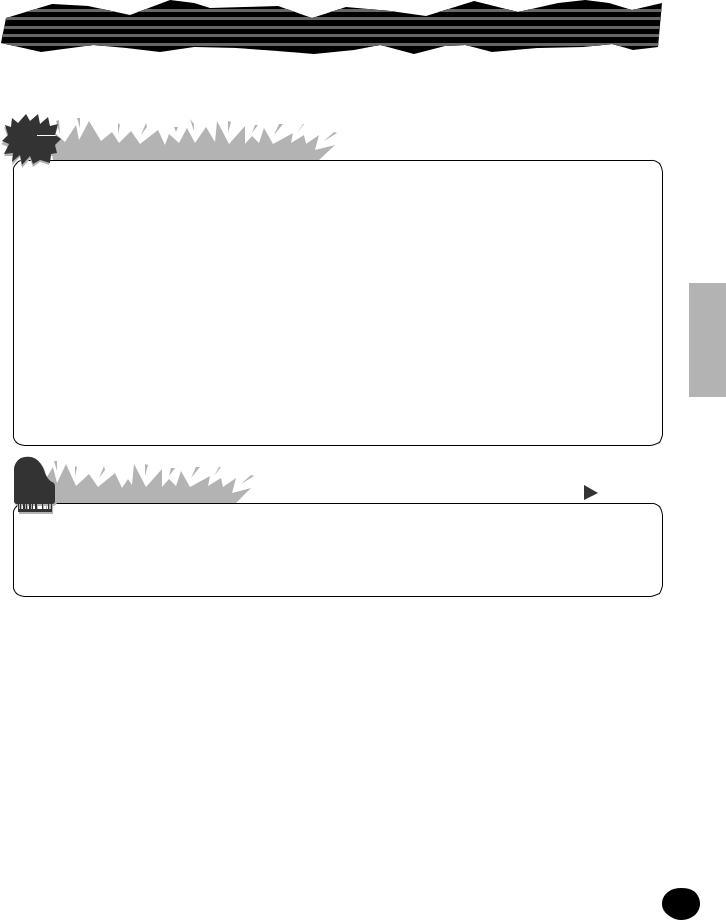
MAIN FEATURES
The PSR-248 is a sophisticated yet easy-to-use keyboard with the following fea-
tures and functions:
 Yamaha Education Suite
Yamaha Education Suite
 page 26-27, 34-35, 37-39
page 26-27, 34-35, 37-39
The PortaTone features the new Yamaha Education Suite — a set of learning tools that utilize the latest technology to make studying and practicing music more fun and fulfilling than ever before!
The Yamaha Education Suite includes:
Powerful Melody Guide functions in the Song mode — Waiting and Minus One — that let you easily learn the 100 songs and even show you what notes to play!
•Waiting pauses song playback (like a patient teacher!), so you can practice at your own pace.
•Minus One mutes only the melody part, letting you play the part yourself. The expert backing parts encourage you to play your best and make it easy to “feel” the song!
Chord Guide functions in the Style mode — Smart and Dictionary — that make it exceptionally easy to learn chords and chord relationships.
•Smart lets you easily play harmonically “correct” chord progressions for whatever key you specify. It’s great for learning — and performing!
•Dictionary is a built-in “chord encyclopedia” that teaches you how to play specific chords. You type in the chord name, and the PortaTone shows you which notes to play!
Portable Grand |
|
page 13 |
|
||
|
The PortaTone also has a Portable Grand function for realistic piano performance. Pressing the PORTABLE GRAND button instantly calls up the stunningly authentic “Stereo Sampled Piano” voice and configures the entire PortaTone for optimum piano play. Special Piano styles — with piano-only accompaniment — are also provided.
Other powerful features include:
•Exceptionally realistic and dynamic sounds with 100 voices, utilizing digital recordings of actual instruments.
•Touch Response lets you dynamically and expressively control the volume of the voices with your playing strength — just as on an acoustic piano.
•100 dynamic auto accompaniment Styles, each with different Intro, Main A and B, and Ending sections. All styles (except for the Piano styles) also have their own four Fill-in patterns.
•Large custom LCD gives you easy, at-a-glance confirmation of all important settings, as well as chord and note indications.
•100 songs, for your listening enjoyment — or for use with the sophisticated learning tools of the Yamaha Education Suite.
•Convenient control over accompaniment Styles — including Tempo and independent Accompaniment Volume.
•One Touch Setting (OTS), for automatically calling up an appropriate voice for playing with the selected Style.
•MIDI terminals for interfacing with other MIDI devices. The PSR-248 also has a Sustain switch jack.
•Built-in, high-quality stereo amplifier/speaker system.
5
3
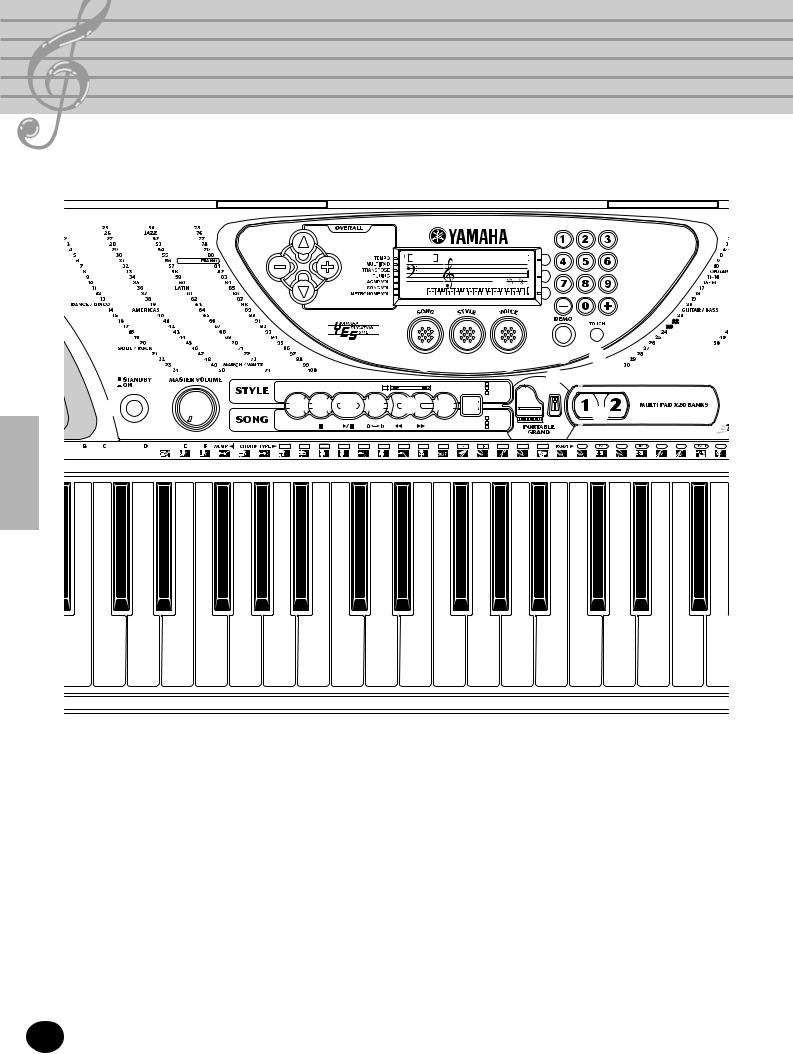
PANEL CONTROLS AND TERMINALS
Front Panel
|
ROCK SHUFFLE |
|
CUMBIA |
6/8 MARCH |
|
|
|
|
|
|
||||
|
SLOW ROCK |
|
|
|
|
|
POLKA |
|
|
|
C |
|
|
|
|
6/8 HVY ROCK |
SWING |
STD WALTZ |
|
|
|
|
|
||||||
|
US ROCK |
B B SWING |
|
POP WALTZ |
|
|
|
|
||||||
K |
16BEAT ROCK |
B B BALLAD |
|
GMN WALTZ |
|
|
|
|
|
|||||
CK |
|
R&B |
JZ QUARTET |
|
|
VIEN WALTZ |
|
|
|
|
|
|||
IUM |
|
SOUL |
DIXIELAND |
|
|
|
2BEAT |
|
|
|
|
|
||
LLAD |
|
FUNK |
|
COOL JAZZ |
|
|
|
|
|
|
|
|
||
ALLAD |
SOUL BALLAD |
JAZZ BALLAD |
|
|
8BEAT |
|
|
|
|
|
||||
BALLAD |
GPL SHUFFLE |
JAZZ WALTZ |
HONKY-TONK |
|
|
|
|
|||||||
BEAT POP |
|
6/8 GOSPEL |
FUSION |
PIANO BALLAD |
|
|
|
|
||||||
T SHUFFLE |
|
4/4 BLUES |
|
|
|
POP BALLAD |
|
|
|
|
||||
6BT BALLAD |
ROCK & ROLL |
BOSSA NOVA |
ARPEGGIO 1 |
|
|
|
|
|||||||
USION BALLAD |
|
BOOGIE |
|
SALSA |
ARPEGGIO 2 |
|
|
|
|
|||||
|
|
|
|
TWIST |
|
SAMBA |
ARPEGGIO 3 |
|
|
|
||||
|
DANCE POP |
|
|
|
|
MAMBO |
DANCE POP |
|
|
|
||||
|
|
TECHNO |
BLUEGRASS |
|
|
BEGUINE |
ROCK PIANO |
|
|
|
||||
|
|
EUROBEAT |
2/4 COUNTRY |
|
|
MERENGUE |
ROCK & ROLL |
|
|
|
||||
|
|
EURO HOUSE |
8BT COUNTRY |
|
|
BLR LENTO |
TIGHT ROCK |
|
|
|||||
|
|
|
HIP HOP |
CBY BOOGIE |
|
REGGAE 1 |
|
SWING |
|
|
||||
|
|
|
70S DISCO |
CTY BALLAD |
|
REGGAE 2 |
JAZZ WALTZ |
|
|
|||||
|
|
|
DISCO TROP |
CTY SHUFFLE |
RHUMBA |
|
RAGTIME |
|
|
|||||
|
|
|
|
|
CTY WALTZ |
|
TANGO |
|
BEGUINE |
|
|
|||
|
|
|
8BT ROCK BLD |
|
|
CAJUN |
|
FOXTROT |
CHA CHA |
|
|
|||
|
|
|
16BT ROCK BLD |
|
|
BANDA |
|
JIVE |
MARCH |
|
||||
|
|
|
|
6/8BALLAD |
|
|
MARIACHI |
|
|
6/8 MARCH |
|
|||
|
|
|
|
|
HARD ROCK |
|
|
TEJANO |
|
MARCH |
GALOP |
|
||
|
|
|
|
|
|
|
|
|
|
|
|
|
ACMP |
SYNC- |
|
|
|
|
|
|
|
|
|
|
|
|
|
ON/OFF |
START |
|
|
|
A |
|
|
|
|
B |
|
|
|
H I |
||
|
|
|
|
|
|
|
MIN |
MAX |
|
|
|
|
||
|
|
|
|
|
|
|
|
|
|
|
|
M |
m |
aug |
|
|
|
|
|
|
|
|
1 |
2 |
|
1 |
2 |
|
B |
|
|
|
001 |
GrandPno |
|
|
|
|
|
|
|
|
|
|
|
||||
|
|
|
|
|
|
|
|
TEMPO |
|
|
|
|
G |
|
|
|
|
|
E O |
|
|
|
|
|
|
|
|
116 |
|
|
|
|
|
|
|
|
|
|
CHU |
|
|
|
|
|
|
|
|
|
|
|
|
|
|
|
|
|
|
|
FULL |
|
|
|
|
|
|
|
|
|
|
|
|
|
|
|
|
|
|
|
WAVE O |
|
|
|
|
|
|
|
|
|
|
|
|
|
|
|
|
|
|
|
ACCORDIO |
|
|
|
|
|
|
|
|
|
|
|
|
|
|
|
|
|
|
HARMONICA |
|
|
|
|
|
|
|
|
|
|
|
|
|
|
|
|
|
|
|
SOFT GUITAR |
|
|
|
|
|
|
|
|
|
|
|
|
|
|
|
|
|
|
|
FOLK GUITAR |
|
|
|
|
|
|
|
|
|
|
|
|
|
|
|
|
|
|
12ST GUITAR |
||
|
|
|
|
|
|
|
|
|
|
|
|
|
|
|
|
|
JAZZ GUITAR |
||
|
|
|
|
|
|
|
|
|
|
|
|
|
|
|
|
|
E GUITAR |
|
|
|
|
|
|
|
|
|
|
|
|
|
|
|
|
|
|
DIST GUITAR |
|
||
|
|
|
|
|
|
|
|
|
|
R |
|
S |
|
|
|
WOOD BASS |
|
|
|
|
|
|
|
D |
|
E |
|
F |
|
|
|
|
|
FINGER BASS |
|
|
|||
|
|
|
|
|
|
|
|
|
|
MUTE BASS |
|
|
|||||||
|
|
|
|
|
|
|
|
|
|
|
|
|
|
|
SLAP BASS |
|
|
|
|
START/ |
INTRO/ |
A |
MAIN |
B |
|
CHORD |
SMART |
|
P |
|
|
|
|
|
|
|
|
|
|
STOP |
ENDING rit. |
AUTO FILL |
OTS |
GUIDE |
DICTIONARY |
O |
METRONOME |
|
|
|
|
|
|
|
|
|
|||
J K |
L |
|
M N |
OFF |
|
|
|
|
|
|
|
|
|
|
|||||
|
|
|
|
|
Q |
|
|
|
|
|
|
|
|||||||
|
|
|
|
|
VOICE |
MELODY |
WAITING |
|
|
|
|
|
|
|
|
|
|
||
|
|
|
|
|
MINUS ONE |
|
|
|
|
|
|
|
|
|
|
|
|||
|
|
|
|
|
CHANGE |
GUIDE |
|
OFF |
|
|
|
|
|
|
|
|
|
|
|
dim |
sus4 |
7 |
m7 |
M7 |
mM7 |
7 5 |
m7 5 |
7sus4 |
m6 |
(9) |
C |
C D |
D |
D |
E |
E |
F |
F G |
G |
L |
C |
M |
S |
H |
|
|
S |
|
B |
L |
M |
H |
H |
|
L |
H |
L |
|
H |
6
4
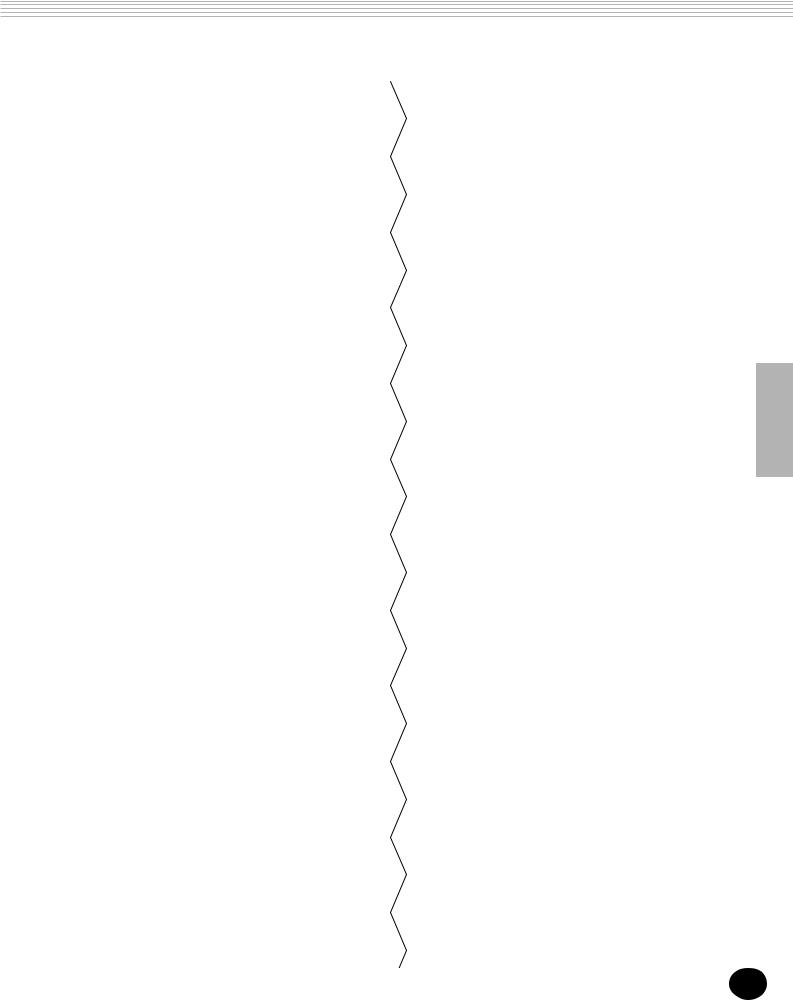
PANEL CONTROLS AND TERMINALS
A Power switch (STANDBY/ON)
B MASTER VOLUME dial
This determines the overall volume of the PortaTone.
C OVERALL buttons (s, t, +, -)
These are for selecting the various “overall” functions and setting their values. (See page 23.)
D SONG button
This selects the Song mode. (See page 20.)
5 STYLE button
This selects the Style mode. (See page 28.)
6 VOICE button
This selects the Voice mode. (See page 15.)
G Numeric keypad, +/- buttons
These are for selecting songs, voices, and styles. (See page 16.) They are also used for entering certain values, such as the time signature for the Metronome (page 14), and the key signature for the Smart Chord function (page 38).
H ACMP ON/OFF button
When the Style mode is selected, this turns the auto accompaniment on and off. (See page 31.) This button has no function in the Song mode.
I SYNC-START, Pause ( ) button
When the Style mode is selected, this turns the Sync-Start function on and off. (See page 29.) When the Song mode is selected, this alternately pauses and starts song playback. (See page 24.)
J START/STOP (>/ ) button
When the Style mode is selected, this alternately starts and stops the auto accompaniment. (See page 29.) When the Song mode is selected, this alternately starts and stops song playback. (See page 24.)
K INTRO/ENDING,  button
button
When the Style mode is selected, this is used to control the Intro and Ending functions. (See pages 29, 30.) When the Song mode is selected, this is used to control the A/B Repeat function. (See page 24.)
L MAIN A/B (AUTO FILL), Fast Forward (f)/Rewind (r) buttons
When the Style mode is selected, these are used to change auto accompaniment sections and control the Auto Fill function. (See page 32.) When the Song mode is selected, these are used to respectively fast forward and rewind during song playback. When Song playback is stopped, they can be used to advance or reverse to specific measure numbers in the song. (See page 24.)
M OTS, VOICE CHANGE button
When the Style mode is selected, this is used to turn the One Touch Setting (OTS) function on and off. (See page 36.) When the Song mode is selected, this is used to turn the Voice Change function on and off. (See page 27.)
N CHORD GUIDE, MELODY GUIDE button
When the Style mode is selected, this is used to control the Chord Guide functions. (See page 37.) When the Song mode is selected, this is used to control the Melody Guide function. (See page 26.)
O PORTABLE GRAND button
This instantly changes to the Voice mode and calls up the Grand Piano voice. (See page 13.)
P METRONOME button
This turns the metronome on and off. (See page 13.)
Q MULTI PAD buttons
These are used to automatically play pre-pro- grammed musical phrases. (See page 40.)
R DEMO button
This is used to play the Demo songs. (See page 11.)
S TOUCH button
This turns the Touch Response function on and off. It also lets you set the Touch Sensitivity setting. (See page 19.)
7
5
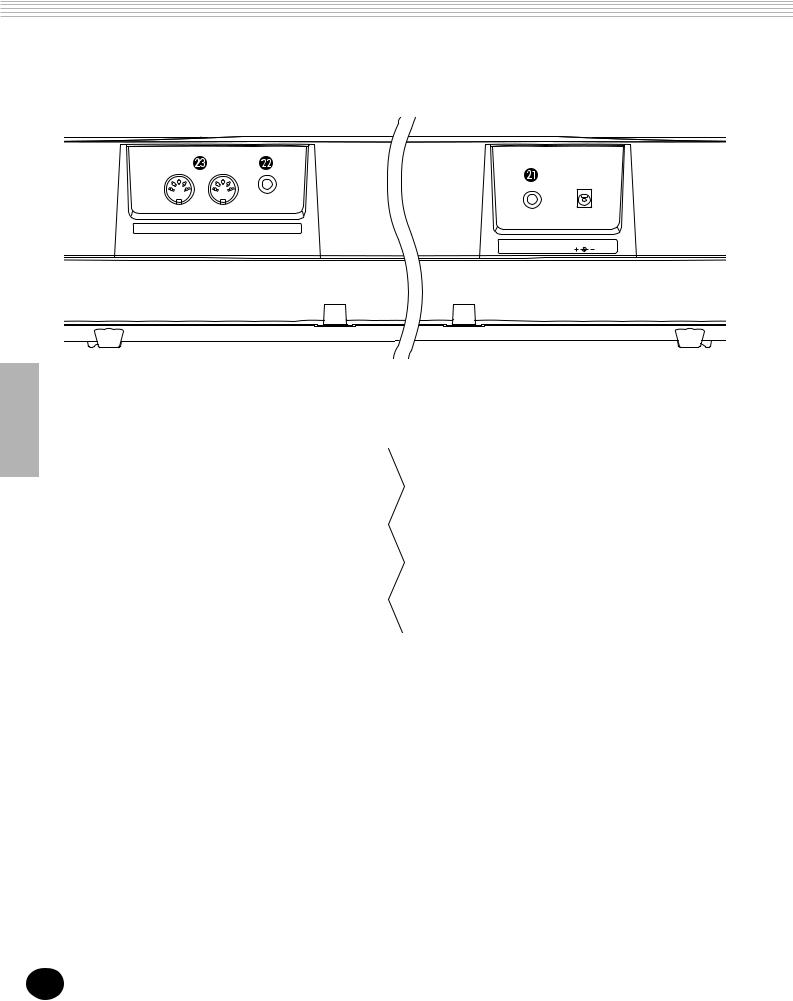
PANEL CONTROLS AND TERMINALS
Rear Panel
T
IN MIDI OUT |
SUSTAIN |
PHONES/ |
DC IN 10-12V |
OUTPUT |
|
T DC IN 10-12V jack
This is for connection to a PA-3B AC power adaptor. (See page 9.)
 PHONES/OUTPUT jack
PHONES/OUTPUT jack
This is for connection to a set of stereo headphones or to an external amplifier/speaker system. (See page 10.)
 SUSTAIN jack
SUSTAIN jack
This is for connection to an optional FC4 or FC5 Footswitch. (See page 10.)
 MIDI IN, OUT terminals
MIDI IN, OUT terminals
These are for connection to other MIDI instruments and devices. (See pages 10, 41.)
8
6
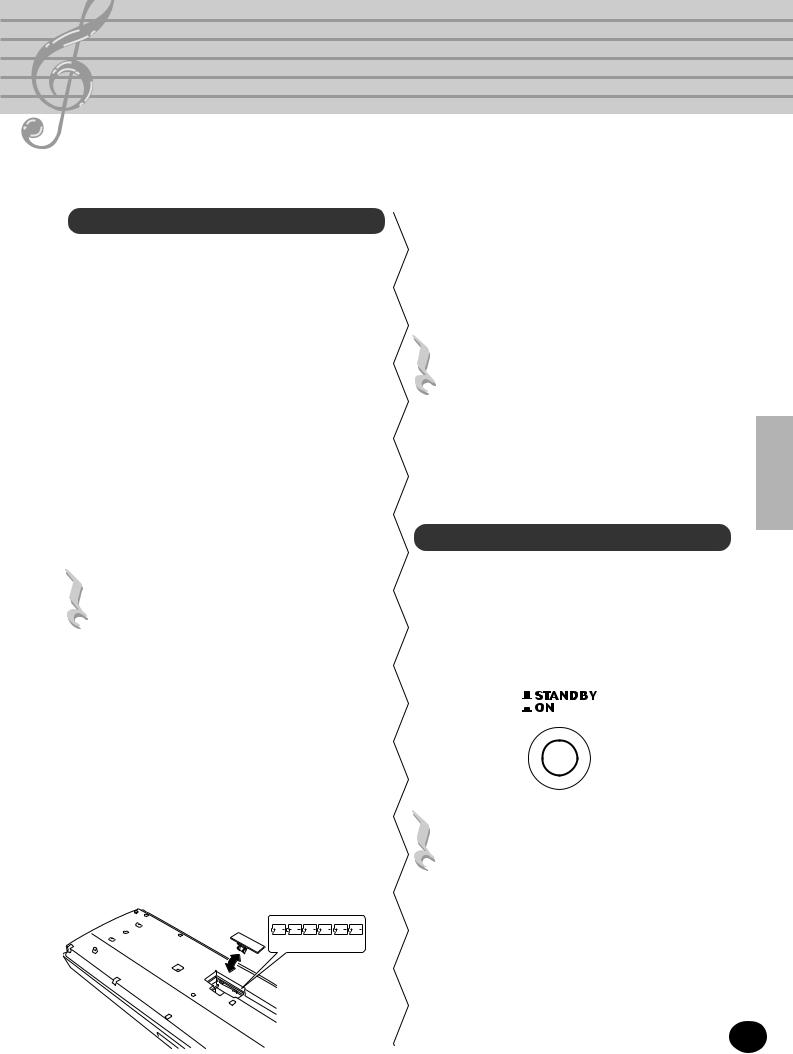
SETTING UP
This section contains information about setting up your PortaTone for playing. Make sure to read this section carefully before using the instrument.
POWER REQUIREMENTS
Although the PSR-248 will run either from an optional AC adaptor or batteries, Yamaha recommends use of an AC adaptor whenever possible. An AC adaptor is more environmentally friendly than batteries and does not deplete resources.
■ When the Batteries Run Down
When the batteries run low and the battery voltage drops below a certain level, the PortaTone may not sound or function properly. As soon as this happens, replace them with a complete set of six new batteries.
 CAUTION
CAUTION
• Never mix old and new batteries or different types of batteries (e.g., alkaline and manganese).
Using an AC Power Adaptor
To connect your PortaTone to a wall socket, you will need the optionally available Yamaha PA-3B Power Adaptor. Use of other AC adaptors could result in damage to the instrument, so be sure to ask for the right kind. Connect one end of the adaptor to the DC IN 10-12V jack on the rear panel of your PortaTone, and the other end to a suitable electrical outlet.
 WARNING
WARNING
•Use ONLY a Yamaha PA-3B AC Power Adaptor (or other adaptor specifically recommended by Yamaha) to power your instrument from the AC mains. The use of other adaptors may result in irreparable damage to both the adaptor and the PSR248.
•Unplug the AC Power Adaptor when not using the PSR-248, or during electrical storms.
• To prevent possible damage from battery leakage, remove the batteries from the instrument if it is not to be used for a long time.
TURNING ON THE POWER
With the AC power adaptor connected or with batteries installed, simply press the STANDBY switch until it locks in the ON position. When the instrument is not in use, be sure to turn the power off. (Press the switch again so that it pops up.)
Using Batteries
■ Inserting Batteries
Turn the instrument upside-down and remove the battery compartment lid. Insert six 1.5-volt size “D” (SUM-1, R-20 or equivalent) batteries as shown in the illustration, making sure that the positive and negative terminals are properly aligned, and replace the lid.
 CAUTION
CAUTION
• Even when the switch is in the “STANDBY” position, electricity is still flowing to the instrument at the minimum level. When you are not using the PSR-248 for a long time, make sure you unplug the AC power adaptor from the wall AC outlet, and/or remove the batteries from the instrument.
BATTERIES 1.5V x 6
9
7
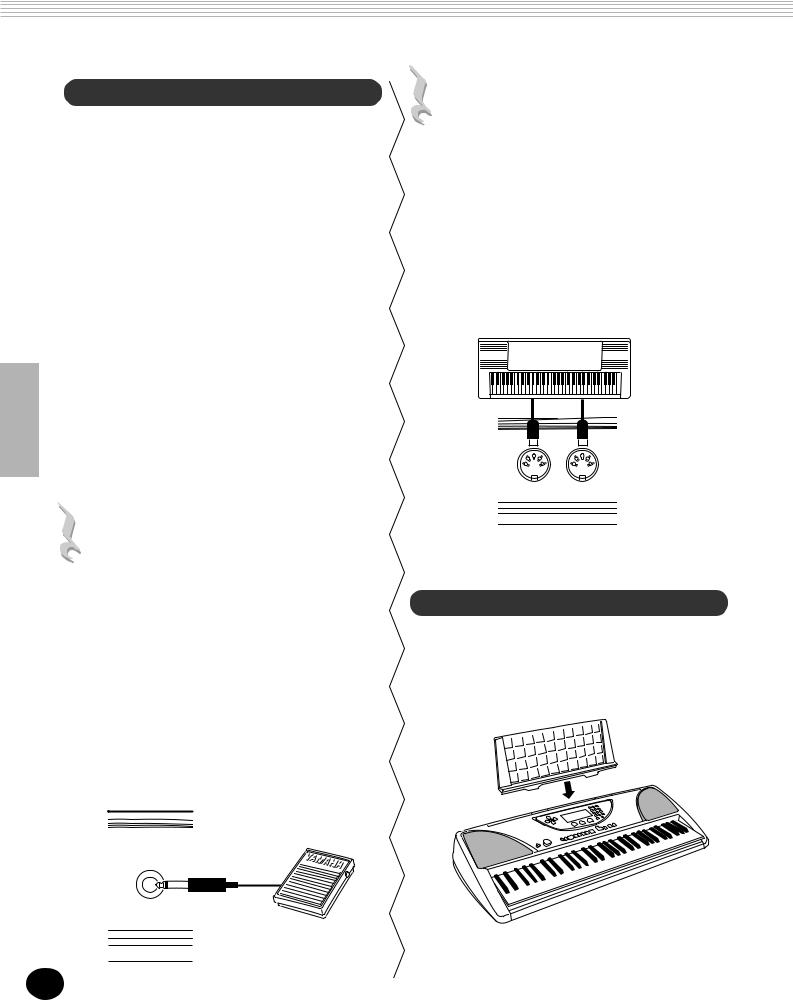
SETTING UP
ACCESSORY JACKS
■ Using Headphones
For private practicing and playing without disturbing others, connect a set of stereo headphones to the rear panel PHONES/OUTPUT jack. Sound from the built-in speaker system is automatically cut off when you insert a headphone plug into this jack.
■ Connecting a Keyboard Amplifier or Stereo
System
Though the PortaTone is equipped with a builtin speaker system, you can also play it through an external amplifier/speaker system. First, make sure the PortaTone and any external devices are turned off, then connect one end of a stereo audio cable to the LINE IN or AUX IN jack(s) of the other device and the other end to the rear panel PHONES/OUTPUT jack on the PortaTone.
 CAUTION
CAUTION
• To prevent damage to the speakers, set the volume of the external devices at the minimum setting before connecting them. Failure to observe these cautions may result in electric shock or equipment damage. Also, be sure to set the volumes of all devices at their minimum levels and gradually raise the volume controls while playing the instrument to set the desired listening level.
■ Using a Sustain Footswitch
This feature lets you use an optional footswitch (Yamaha FC4 or FC5) to sustain the sound of the keyboard voice. This is used in the same way as a damper pedal on an acoustic piano — press and hold down the footswitch as you play the keyboard to sustain the sound.
NOTE:
•Make sure that the footswitch plug is properly connected to the SUSTAIN jack before turning on the power.
•Do not press the footswitch while turning the power on. Doing this changes the recognized polarity of the footswitch, resulting in reversed footswitch operation.
■ Using the MIDI Terminals
The PortaTone also features MIDI terminals, allowing you to interface the PortaTone with other MIDI instruments and devices. (For more information, see page 41.)
 MIDI instrument
MIDI instrument 
IN MIDI OUT
MUSIC STAND
Insert the bottom edge of the included music stand into the slot located at the top rear of the PortaTone control panel.
SUSTAIN
10
8
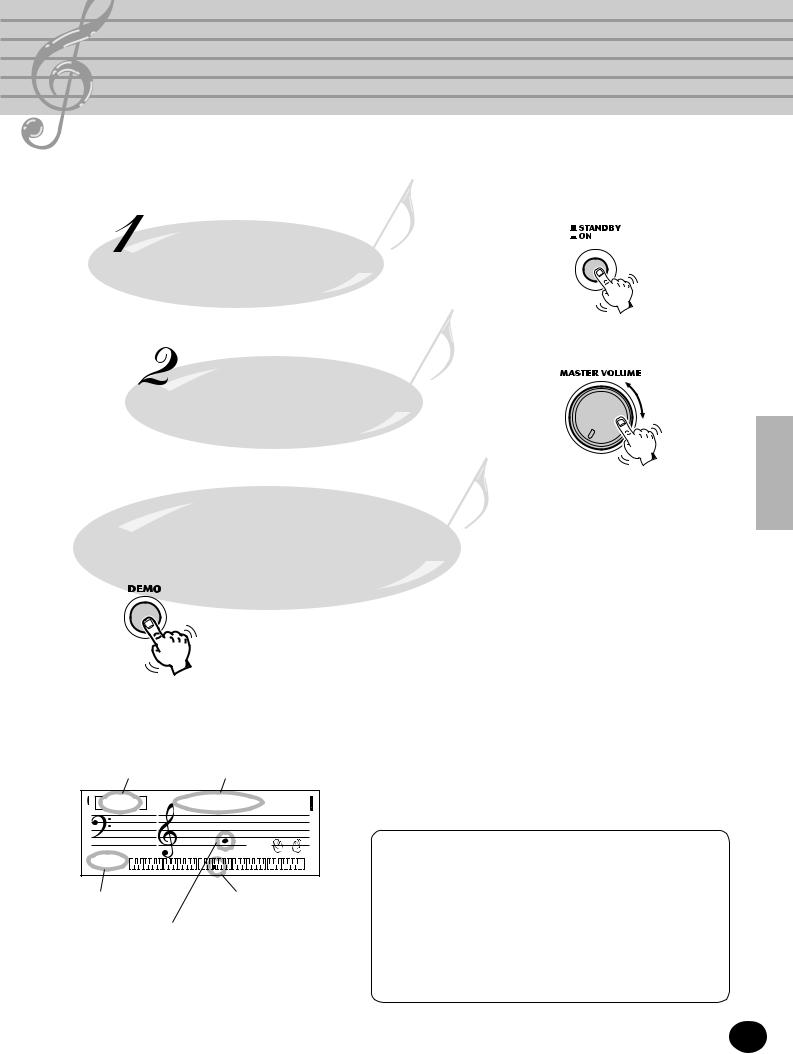
GETTING STARTED —
PLAYING THE DEMO SONGS
The PortaTone has a huge variety of Demo songs, specially recorded to showcase the dynamic sounds and rhythms and give you an idea of what you can do with the instrument.
First, turn on the power.
Press the STANDBY/ON button. Whenever the power is turned on, the Voice mode is automatically called up and set to play Voice 1 (GrandPno).
Set the Volume.
Initially, turn the MASTER VOLUME control about a third of the way up. You can adjust the control for optimum level once the songs start playing.
MIN
 Press the DEMO button.
Press the DEMO button.
All 100 songs will play in sequence. You can play along on the keyboard with the songs. If the Voice Change function is on (page 27), the keyboard voice will change to match the changes in the song of the melody voice.
The current song name and number appear at the left of the display. Notice also that the display indicates both the chords (except for song #1, “StarWars”) and the melody notes (in the music staves and the keyboard diagram) as they change during the song. (Scores for the Demo songs are provided.)
Song number |
Song name |
To stop playback, press the START/STOP (>/■) |
|
|
button. For information on selecting and playing |
001 |
StarWars |
individual songs, see page 20. |
|
MEASURE 002 |
While the Demo song is playing... |
|
|
Many features of the PortaTone can be used while the |
|
|
Demo songs are playing. These include: |
Current chord |
Keyboard diagram |
|
|
(current note is dark) |
• Tempo (page 21) |
|
|
|
Melody notation |
|
• Song volume (page 23) |
|
|
• Tuning (page 19) |
|
|
• Pause ( ), Rewind (r), Fast Forward (f) (page 24) |
|
|
• Voice Change (page 27) |
11
9
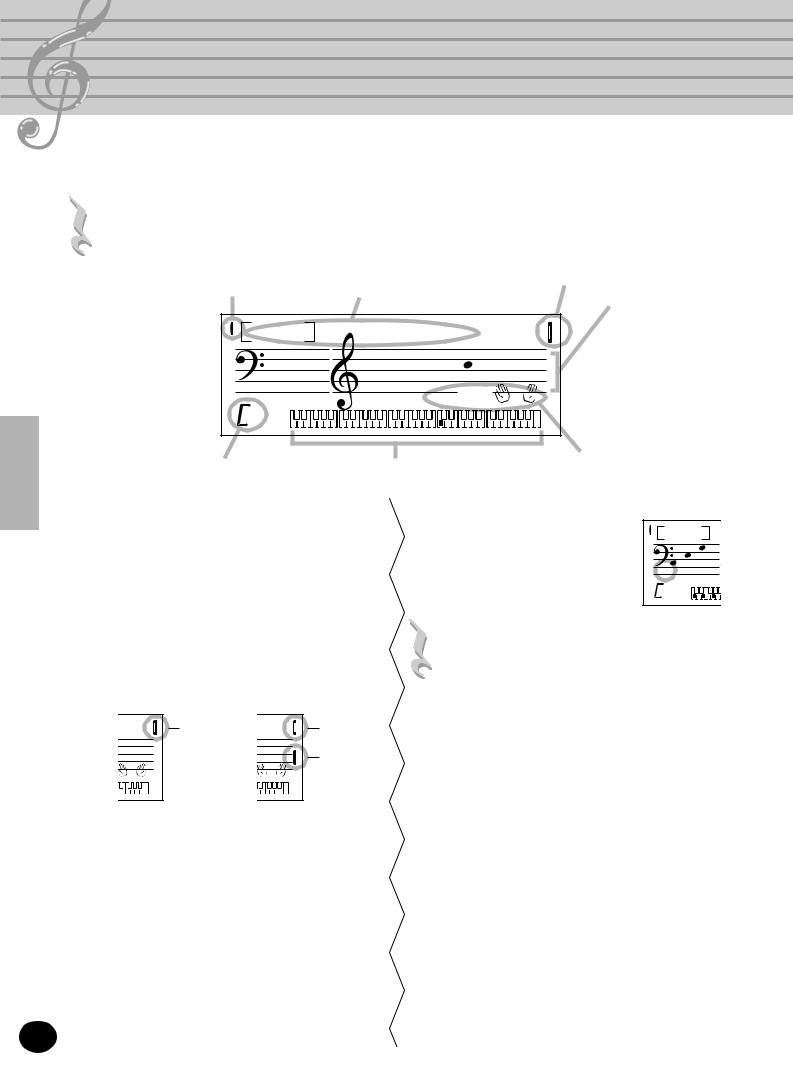
PANEL DISPLAY INDICATIONS
The PortaTone features a large multi-function display that shows all important settings for the instrument. The section below briefly explains the various icons and indications in the display.
NOTE:
The LCD’s backlight will gradually dim over a long period of use. When the display becomes dim or hard to read, contact the store where you purchased the instrument or, Yamaha directly, to have the LCD replaced. A fee will be charged for replacement.
B Overall function |
G Song/Voice/Style name |
A Mode indicator |
bar indicator |
and number |
C Notation |
|
|
TEMPO |
002 |
WholeNew |
|
|
|
|
|
MULTI PAD |
|
|
|
TRANSPOSE |
|
|
|
TUNING |
|
|
|
ACMP VOL |
|
MEASURE 003 |
|
SONG VOL |
|
|
|
|
|
|
|
METRONOME VOL |
|
|
|
F Chord |
D Keyboard |
E Measure/Tempo |
|
and beat |
|||
A Mode indicator
These dark bars indicate the currently selected mode: Song, Voice, or Style. A C-shaped bar (at SONG or STYLE) indicates that the mode is active in the background.
In the first example, the Song mode is selected. In the second example, the Voice mode is selected, but the Song mode is active in the background. (This means that the song controls below the display are active and can be used to play the currently selected song.)
EX.1 |
Song |
EX.2 |
Song |
|
|
||
|
mode |
|
mode |
Voice mode
B Overall function bar indicator
The PortaTone has seven Overall functions or controls. The currently selected function is indicated by a dark bar that appears next to its name (printed on the panel).
C Notation
D Keyboard
These two portions of the display conveniently indicate notes currently played on the keyboard. When a song is being played back, they show the single notes of the melody in succession. When
1212 the Style mode and auto accompaniment are
active, the display also shows the specific notes of the current chord. The indication “8va” appears at the lower or upper part of the notation staff for a note or notes that are respectively an octave lower or higher than notated.
003 |
8va |
NOTE:
For a few specific chords (such as BM7), not all notes may be shown in the notation section of the display. This is due to space limitations in the display.
E Measure/Tempo and beat
This shows either the current measure (when the Song mode is selected) or the current Tempo value (when the Style mode is selected). The hand clap icons also flash to indicate the beats in the measure during song or style playback. (See page 22.)
F Chord
When a song is being played back, this indicates the current chord root and type. It also indicates chords played in the ACMP section of the keyboard when the Style mode and auto accompaniment are on.
G Song/Voice/Style name and number
This portion of the display indicates the name and number of the currently selected song, voice, or style. When other functions of the PortaTone are selected, it briefly shows the function name and current value or setting.
10
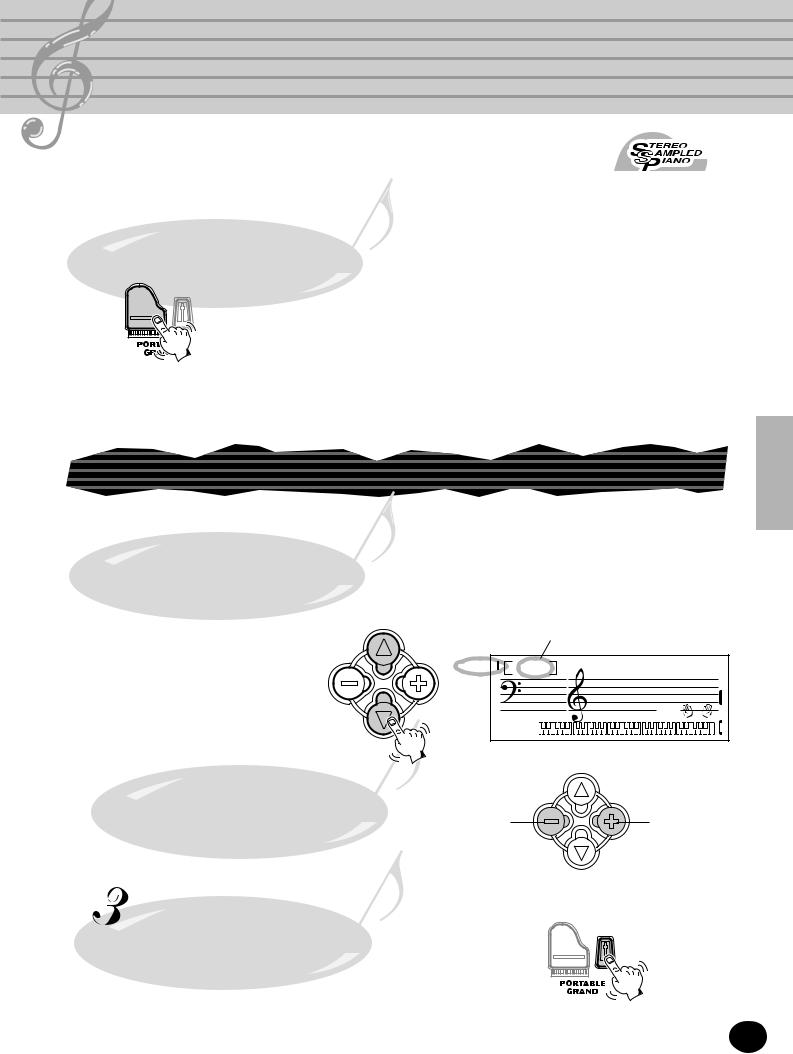
PORTABLE GRAND
This convenient function lets you automatically exit from any other mode or function and instantly call up the Grand Piano voice.
Press the piano-shaped PORTABLE GRAND button.
METRONOME
Doing this automatically cancels any other mode or function, and resets the entire instrument for playing the special “Stereo Sampled Piano” Grand Piano voice (voice 001). It automatically selects the Song mode, calling up song #72, “Für Elise” — which can be played instantly by pressing the START/STOP (>/■) button. It also sets the Multi Pads to special piano phrases, and calls up style #81 (“2beat”).
USING THE METRONOME
 Set the desired tempo with the Tempo function in the Overall menu.
Set the desired tempo with the Tempo function in the Overall menu.
Press one of the OVERALL s/t buttons, repeatedly if necessary, until
“Tempo” appears in the display.
Current Tempo value
 Change the value.
Change the value.
Use the OVERALL +/- buttons to increase or decrease the Tempo value. Holding down either button continuously increases or decreases the value. 
TEMPO |
116 |
Tempo |
|
||
|
|
TEMPO |
|
|
116 |
Decreases |
Increases |
Tempo value |
Tempo value |
Turn on the Metronome.
METRONOME
Press the METRONOME button.
To turn the Metronome off, press the METRONOME button again.
13
11
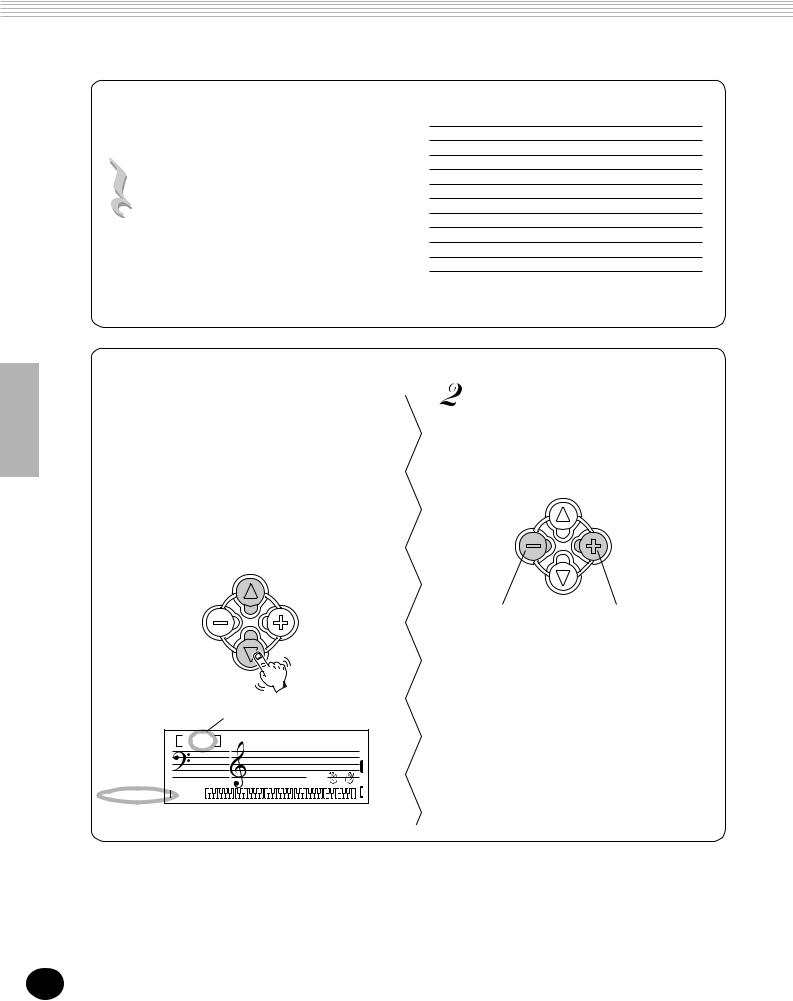
PORTABLE GRAND
Setting the Metronome Time Signature
The time signature of the Metronome can be set to various quarter-note based meters.
NOTE:
The time signature changes automatically when a style or song is selected.
Simultaneously hold down the METRONOME button and press the button on the numeric keypad that corresponds to the desired time signature (see chart at right).
Adjusting the Metronome Volume
You can adjust the volume of the Metronome sound independently of the other PortaTone sounds. The volume range is 000 - 127.
 Select the Metronome Volume function in the Overall menu.
Select the Metronome Volume function in the Overall menu.
Press one of the OVERALL s/t buttons, repeatedly if necessary, until “MtrVol” appears in the display.
Current Metronome value |
|
100 |
MtrVol |
|
TEMPO |
|
116 |
METRONOME VOL |
|
Numeric Time keypad signature
1Plays only “1” beats (all high clicks)
22/4
33/4
44/4
55/4
66/4
77/4
88/4
99/4
0 |
Plays no “1” beats (all low clicks) |
Change the value.
Use the OVERALL +/- buttons to increase or decrease the Metronome Volume value. Holding down either button continuously increases or decreases the value.
Decreases Metronome |
Increases Metro- |
Volume value |
nome Volume value |
Restoring the Default Metronome Volume Value To restore the default Metronome Volume value (100), press both OVERALL +/- buttons simultaneously (when Metronome Volume is selected in the Overall menu).
14
12
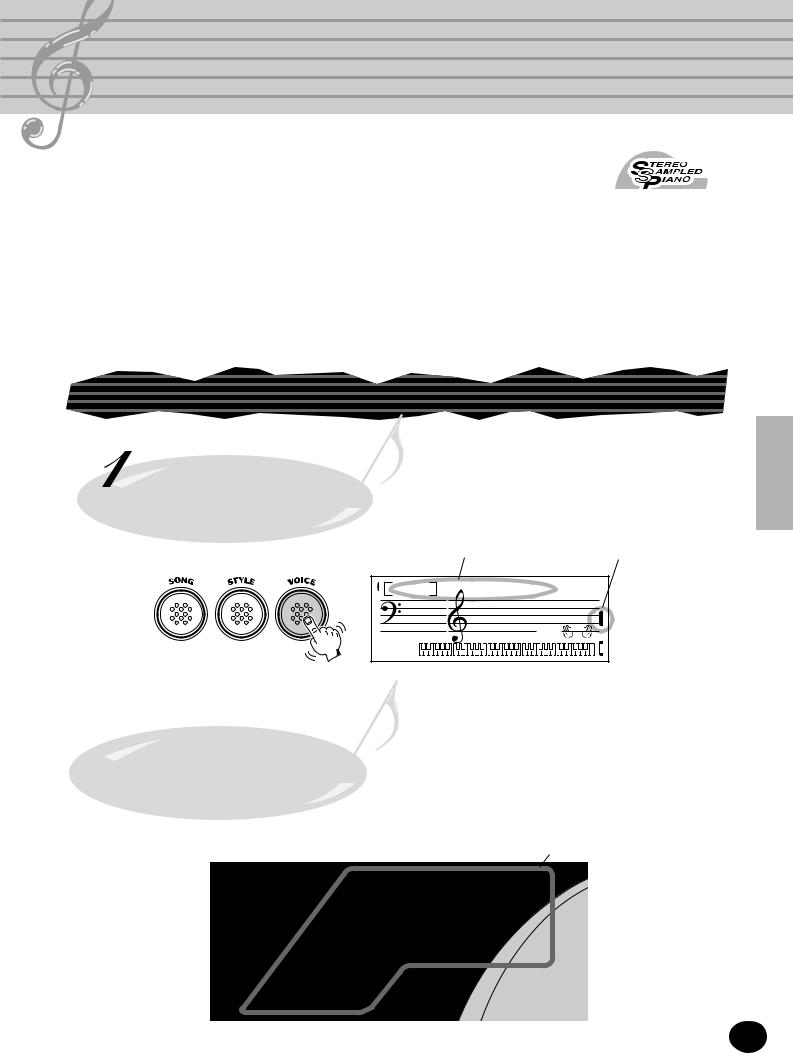
SELECTING AND PLAYING VOICES —
THE VOICE MODE
The Voice mode features 100 authentic voices that have been created with Yamaha’s sophisticated AWM (Advanced Wave Memory) tone generation system. Many of these voices also have special preset characteristics or embellishments. The voices are divided into various categories depending on their characteristics or the effects used.
SELECTING AND PLAYING A VOICE
Select the Voice mode.
Press the VOICE button.
Voice name and number |
Indicates Voice mode is |
selected |
001 |
GrandPno |
|
TEMPO |
|
116 |
 Select the desired voice number.
Select the desired voice number.
Use the numeric keypad. The basic categories of voices and their numbers are shown at the right side of the panel. A complete list of the available voices is given on page 44.
Voice list
|
|
GRAND PIANO |
STRINGS |
THICK LEAD |
|
|
|
PIANO |
|
VIOLIN |
SIMPLE LEAD |
|
|
HONKY-TONK |
|
CELLO |
THICK SAW |
|
|
E PIANO 1~4 |
|
HARP |
SIMPLE SAW |
|
|
HARPSICHORD |
|
SITAR |
SYNTH BASS |
|
CLAVI |
|
BANJO |
SY STRINGS |
|
|
CELESTA |
|
UKULELE |
SY BRASS 1~2 |
|
|
|
|
|
VIBRAPHONE |
RISING |
|
E ORGAN 1~4 |
|
MARIMBA |
SLOW STRS |
|
|
CHURCH ORG 1~2 |
|
STEEL DRUMS |
HARMONY |
|
|
FULL ORGAN |
|
|
SPLIT |
|
|
WAVE ORGAN |
TRUMPET |
ECHO |
||
|
ACCORDION |
TROMBONE |
DUAL |
||
|
HARMONICA |
MUTE TRPET |
DRUM KIT |
||
|
|
FRENCH HORN |
|
||
SOFT GUITAR |
BRASS SECT |
|
|||
FOLK GUITAR |
ALTO SAX |
|
|
|
|
12ST GUITAR |
TENOR SAX |
|
|
|
|
JAZZ GUITAR |
CLARINET |
|
|
|
|
E GUITAR |
|
FLUTE |
|
STAR WARS MAIN TITLE |
|
DIST GUITAR |
PAN FLUTE |
|
A WHOLE NEW WORLD |
||
WOOD BASS |
|
|
|
FAVORITE |
|
FINGER BASS |
|
|
|
CHRISTMAS |
|
MUTE BASS |
|
|
CHILDREN |
|
|
SLAP BASS
15
13

SELECTING AND PLAYING VOICES — THE VOICE MODE
There are three ways to select voices: 1) directly entering the voice number with the numeric keypad, 2) using the +/- keys to step up and down through the voices, or 3) pressing the VOICE button to advance through the voice numbers.
Using the numeric keypad
Enter the digits of the voice number as printed on the panel. For example, to select voice #42, press “4” on the numeric keypad, then “2.”
042 |
Trombone |
|
TEMPO |
|
116 |
NOTE:
When selecting Voice numbers 1 - 10, the PortaTone pauses briefly before changing to the voice. (However, you can quickly select the voice by pressing all three digits; for example, select voice #9 by pressing “0,” “0,” then “9.”) Pressing only “0” does not change the voice.
Using the +/- keys
Press the + key to select the next voice number, and press the - key to select the previous voice. Holding down either key continuously scrolls up or down through the numbers. The +/- keys have a “wrap around” feature. For example, pressing the + key from the voice 100 returns to voice 1.
Using the VOICE button
Press the VOICE button to select the next voice number. (This functions exactly the same as the + button.)
NOTE:
Each voice is automatically called up with the most suitable octave range setting. Thus, playing middle C with one voice may sound higher or lower than another voice at the same key.
16
14
